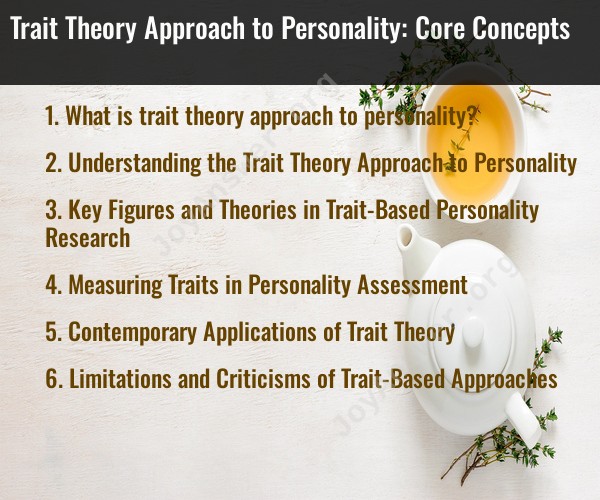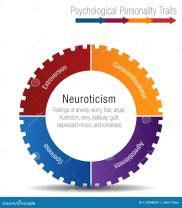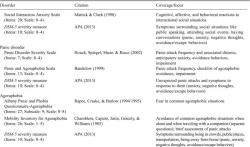What is trait theory approach to personality?
Trait theory is a psychological approach to understanding personality that focuses on identifying and measuring specific, enduring traits or characteristics that make up an individual's personality. The trait theory of personality is based on the idea that people have consistent and stable patterns of behavior, thoughts, and feelings that can be described and categorized.
Key concepts of the trait theory approach to personality include:
Traits: Traits are relatively stable and consistent patterns of behavior, thoughts, and emotions that distinguish one person from another. Traits are often thought of as underlying, enduring qualities that help predict how individuals are likely to behave in different situations.
Trait Descriptions: Trait theory aims to describe and categorize these traits using specific descriptors or adjectives. Commonly used traits include words like "outgoing," "conscientious," "introverted," "agreeable," "emotional," and "open to experience."
Trait Dimensions: Traits are often organized into dimensions or factors that capture related traits. For example, the Five Factor Model (also known as the Big Five) is one of the most well-known models and includes five major dimensions: Openness, Conscientiousness, Extraversion, Agreeableness, and Neuroticism (OCEAN).
Trait Assessment: Researchers and psychologists use various methods to assess and measure traits. These methods include self-report questionnaires, interviews, and observational techniques. The goal is to quantify and compare individuals' traits.
Consistency Over Time and Situations: Trait theory suggests that individuals exhibit consistent patterns of behavior across various situations and over time. For example, a person described as "conscientious" is expected to display careful, organized behavior in different settings.
Trait Hierarchy: Traits can be organized in a hierarchical structure, with broader dimensions (e.g., the Big Five) encompassing narrower, more specific traits. This allows for a comprehensive understanding of an individual's personality.
Trait Stability and Change: Trait theory acknowledges that while many traits are stable over time, some traits may change or develop in response to life experiences, maturation, or environmental factors. However, the focus remains on identifying the core, relatively stable traits.
Trait Consistency Across Cultures: Some traits are believed to have cross-cultural relevance, although the expression of traits may vary in different cultural contexts.
Trait theory has been influential in psychology and has led to the development of various personality assessment tools, including well-known tests like the Minnesota Multiphasic Personality Inventory (MMPI), the Myers-Briggs Type Indicator (MBTI), and the NEO-PI-R (a measure of the Big Five personality traits).
While trait theory provides a valuable framework for understanding personality, it is important to note that it has been critiqued for oversimplifying the complexity of human personality and for not accounting for situational influences on behavior. Nevertheless, it remains a useful tool for exploring and discussing personality traits and their role in human behavior and individual differences.
Understanding the Trait Theory Approach to Personality
Trait theory is a prominent approach in personality psychology that focuses on identifying and measuring relatively stable personality traits that influence an individual's thoughts, feelings, and behaviors. It suggests that people possess various traits, such as extroversion, agreeableness, and neuroticism, which can be used to describe their overall personality structure.
Key Principles of Trait Theory:
Individual Differences: Each individual possesses a unique combination of traits that contribute to their personality.
Trait Stability: Traits are relatively stable over time and tend to persist across different situations.
Trait Influence: Traits influence an individual's behavior, choices, and interactions with the world.
Key Figures and Theories in Trait-Based Personality Research
Several influential figures and theories have shaped trait-based personality research:
Gordon Allport: Allport identified thousands of personality traits and categorized them into three levels: cardinal, central, and secondary.
Hans Eysenck: Eysenck's Eysenck Personality Questionnaire (EPQ) proposed three fundamental personality dimensions: extroversion-introversion, neuroticism-stability, and psychoticism.
Raymond Cattell: Cattell reduced Allport's list of traits to sixteen primary factors using factor analysis, forming the basis of the Sixteen Personality Factor Questionnaire (16PF).
Lewis Goldberg: Goldberg's Five-Factor Model (FFM) or the Big Five personality traits – extraversion, agreeableness, conscientiousness, neuroticism, and openness to experience – is the most widely accepted and researched trait model today.
Measuring Traits in Personality Assessment
Various methods are used to measure personality traits, including:
Self-report questionnaires: Self-assessment inventories like the NEO Personality Inventory-Revised (NEO-PI-R) or the Big Five Inventory (BFI) allow individuals to rate their own personality traits based on statements or questions.
Observer ratings: Trained observers rate an individual's behavior and personality traits based on direct observation or interactions.
Projective tests: Projective tests, such as the Rorschach Inkblot Test or the Thematic Apperception Test (TAT), present ambiguous stimuli and assess an individual's interpretation and responses, revealing underlying personality traits.
Contemporary Applications of Trait Theory
Trait theory has broad applications in various fields, including:
Clinical Psychology: Understanding personality traits can aid in diagnosing mental health disorders, predicting treatment outcomes, and developing personalized interventions.
Organizational Psychology: Assessing personality traits can help in employee selection, predicting job performance, and fostering team dynamics.
Education: Trait theory can inform teaching methods, student motivation strategies, and personalized learning approaches.
Social Psychology: Studying personality traits can provide insights into social interactions, group dynamics, and leadership styles.
Limitations and Criticisms of Trait-Based Approaches
Trait theory has been criticized for its focus on describing traits rather than explaining their underlying causes or mechanisms. Additionally:
Trait Stability: The assumption of trait stability has been challenged by research suggesting that traits can change over time and in response to significant life events.
Cultural Sensitivity: Trait theory has been criticized for its potential Western bias, as trait definitions and assessments may not fully capture the nuances of personality across diverse cultures.
Individual Complexity: Trait theory may oversimplify the complexity of human personality by focusing on a limited number of traits, potentially overlooking individual differences and unique personality patterns.
Despite these limitations, trait theory remains a valuable framework for understanding and predicting personality, and ongoing research continues to refine and expand our knowledge of personality traits and their implications.












